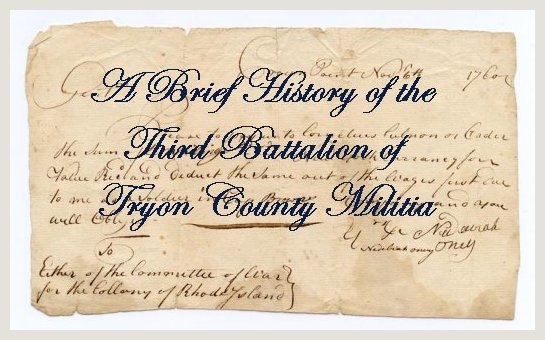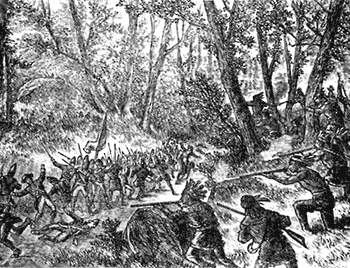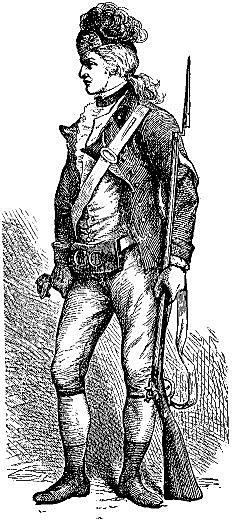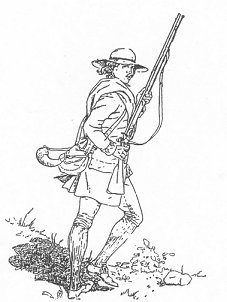

In 1776, the Third Battalion was employed in watching and arresting suspicious loyalists. In January the Tryon County Militia, in conjunction with the Albany County Militia under General Philip Schyler, marched to Johnstown and forced Sir John Johnson and his loyalist tenants to surrender all their military stores and sign their parole not to take up arms against the newly formed American government.
For the remainder of the year they were busy making fortifications, scouting, doing garrison duty in various forts (Fort Johnstown, Fort Hunter, etc.) and out on alarms searching for approaching enemies that never appeared. At times officers were replaced after resigning or after changing loyalties and fleeing to Canada. Lieutenant-Colonel Fonda resigned and Volkert Veeder was appointed to that position in his place.
In January of 1777, detachments from all four regiments of the Tryon County Militia were sent to Fort Ticonderoga to cut trees to be used in building a floating bridge across Lake Champlain to Vermont. Thus they were employed along with the garrison and other duties.
On June 27th, a conference was held at Unadilla between Captain Joseph Brant, with about 150 warriors, and Brigadier General Nicholas Herkimer, with about 200 men from the Tryon County Militia regiments. Although hoping to sway Captain Brant to the American cause, or at least to remain neutral, the conference ended with Brant and the Mohawks remaining loyal to King George the Third.
On August 6th, one of the bloodiest battles ever fought on New York State soil took place in a ravine at a place called Oriskany.  The Tryon County Militia, under General Herkimer, was ambushed by a large force of Indians and Loyalists (known as the King's Royal Regiment of New York) who were led by Colonel Sir John Johnson. General Herkimer was wounded, and Colonel Ebenezer
The Tryon County Militia, under General Herkimer, was ambushed by a large force of Indians and Loyalists (known as the King's Royal Regiment of New York) who were led by Colonel Sir John Johnson. General Herkimer was wounded, and Colonel Ebenezer  Cox and about 150 to 200 men were killed from the four regiments of civilian soldiers known as militia. The following known casualties from the Third Battalion were 13 men killed, 13 wounded (including Col. Fisher), and Major Bliven and Petrus Groot were both wounded and taken prisoner.
Cox and about 150 to 200 men were killed from the four regiments of civilian soldiers known as militia. The following known casualties from the Third Battalion were 13 men killed, 13 wounded (including Col. Fisher), and Major Bliven and Petrus Groot were both wounded and taken prisoner.
Lieutenant-Colonel Veeder and a detachment from the Third Battalion marched to Stillwater about the 1st of September where they joined the American Army under General Horatio Gates. They were there during both battles and actively took part in the Battle of Bemis Heights on October 7th, following General Benedict Arnold into the German redoubt. During this charge, the Third's Adjutant Peter Conyne (from Tribes Hill) fell wounded, but later recovered from the wound to serve again.
In 1778 and 1779, the Third Battalion was busy guarding against enemy incursions, performing garrison duty, and building fortifications, such as the Sacondaga Blockhouse. On March 15th, 1779, Colonel Fisher sent a return to Governor George Clinton giving the strength of the Third Regiment of ten companies with 326 men (including officers). This is one of the very few returns for the regiment known to exist. The return showed the strength of the various companies; the smallest company with 25 men including officers, to the largest which had 60 men including officers.
In April of 1779, besides building the Sacondaga Blockhouse, the regiment was busy gathering and transporting supplies for General James Clinton who was encamped at Canajoharie preparing to later march and join General John Sullivan and campaign against New York's western Indians.
Captain Garret Putman with a few men from the Third Battalion joined General Clinton as volunteers under Colonel John Harper and shortly afterwards Captain Putman was appointed second in command of the volunteers. They were involved in all the skirmishes and the Battle of Newtown that was fought on August 29th.
On May 15th, 1780, Captain Andrew Wemple and several men in his company deserted from the Third Battalion and fled to Canada in the wake of an invasion soon to be launched by Colonel Sir John Johnson from Canada into the Mohawk Valley.
Finally, on May 22nd, the rumors became a reality when Sir John Johnson and about 500 Indians, Loyalists, and British regulars entered the Mohawk District of Tryon County and burned Caughnwaga (present day Fonda area), Tribes Hill, and Johnstown. Besides burning over one hundred buildings, Johnson took over fifty prisoners, many of who were local militia officers and men of influence such as the Fondas and Sammons. Johnson's forces of incendiaries also killed ten men and there is only one woman known to have been tomahawked. However, she soon recovered from the incident. This woman was the mother of Colonel Fisher.
Some of those killed were Douw Fonda (a man in his seventies), Captain John and Harmon Fisher (brothers of the colonel), Lieutenant Hendrick Hanson, Corporal Amasa Stevens, Aaron and Lodowick Putman, William Gault and James Plateau (these last two men were loyalists). Colonel Fisher was tomahawked, scalped and left for dead. He not only survived his wounds like his mother, but he lived a very active life, serving as General of the Montgomery County Militia after the war. He died in 1809.
On October 17th, Sir John, with another force of incendiaries, attacked the Schoharie Valley and burned everything in their path. On October 18th, Johnson and his men arrived in the Mohawk Valley, burned the settlement near Fort Hunter, took prisoners, and skirmished with the local militia before finally camping for the night.
On October 19th, Johnson marched for Stone Arabia to destroy it. On arriving at Stone Arabia, Johnson fell in with a party of Americans under Colonel John Brown and a heated battle quickly ensued. The battle ended with an American defeat and Colonel Brown with forty of his men were left dead in the fields of the heights of Stone Arabia.
Johnson continued along the Mohawk River again burning everything in his path. Later that day, 500 men from the Albany County and Tryon county Militias, under General Robert Van Rensselaer, caught up with the enemy (near present day St. Johnsville) and another battle soon raged. 
Unfortunately, Johnson and his men escaped under the cover of darkness and returned to Canada with losing about 50 men taken prisoner, killed and/or wounded. The Third Battalion, under Lieutenant Colonel Veeder, suffered only to have Sergeant Hugh McMaster wounded in this battle.
On July 9, 1781, Currytown, a settlement in the Mohawk Districh (now the town of Root), was destroyed by a force of Indians and Loyalists under Lieutenant John Dockstader. On July 10th, Colonel Marinus Willett with about 200 American soldiers found the enemy encampment in a cedar swamp in New Dorlach (now Sharon, Schoharie County). The enemy retreated from the field after about an hour and a half of fierce fighting when more Tryon County Militia(Mostly the Second and Third Batalions) under Captain Abraham Veeder arrived. Colonel Willett and his men Burried the dead and gathered the wounded and returned to Fort Rensselaer.
On October 24th, Major John Ross with about 600 Indians, Loyalists, Germans, and British Regulars Burned the settlements From Currytown to Warrenbush. They then crossed the Mohawk River and Headed for the vilage of Johnstown.
On October 25th, Colonel Willett with about 400 men from the New York and Massachusetts levies and the Tryon County Militia Found Major Ross and his men encamped near Johnson Hall and attacked them. A fierce battle was fought until darkness fell over the battlefield and the enemy under Major Ross made their escape. The Third Batallion had lost Sergeant John Eikler, killed; Captain John Little, Sergeant Michael Myers, Privates Rea Guiles and Philip Martin were wounded and Private Jeremiah Crowley was taken prisoner. This would be the last battle fought during the American Revolution on New York State soil.
On October 30th, Colonel Willett, after pursuing Major Ross through the wilderness for several days, met a rear guard of Major Ross' detachment under Captain Walter Butler at West Canada Creek, and a sharp skirmish ensued.  After a few minutes of fighting, Captain Butler fell wounded and three more of the enemy fell dead. The remainder of the enemy's rear guard fled. On crossing the creek, Butler was found to be still alive, but he had been tomahakwed and scalped by an Oneida Indian named Anthony. Colonel Willett halted his troops and decided not to pursue the enemy any further for fear of a possible ambush ahead on the trail. Willett then returned to Fort Rensselaer without losing a man.
After a few minutes of fighting, Captain Butler fell wounded and three more of the enemy fell dead. The remainder of the enemy's rear guard fled. On crossing the creek, Butler was found to be still alive, but he had been tomahakwed and scalped by an Oneida Indian named Anthony. Colonel Willett halted his troops and decided not to pursue the enemy any further for fear of a possible ambush ahead on the trail. Willett then returned to Fort Rensselaer without losing a man.
In 1782 and 1783, the Third Battalion saw active garrison duties in the Mohawk Valley. They were out on a few alarms but they were in no major engagements. Finally, in April of 1783, peace came to the Mohawk Valley that ended English rule.
In April of 1784, Tryon County was renamed to Montgomery County in honor of General Richard Montgomery who was killed at Quebec in December of 1775.